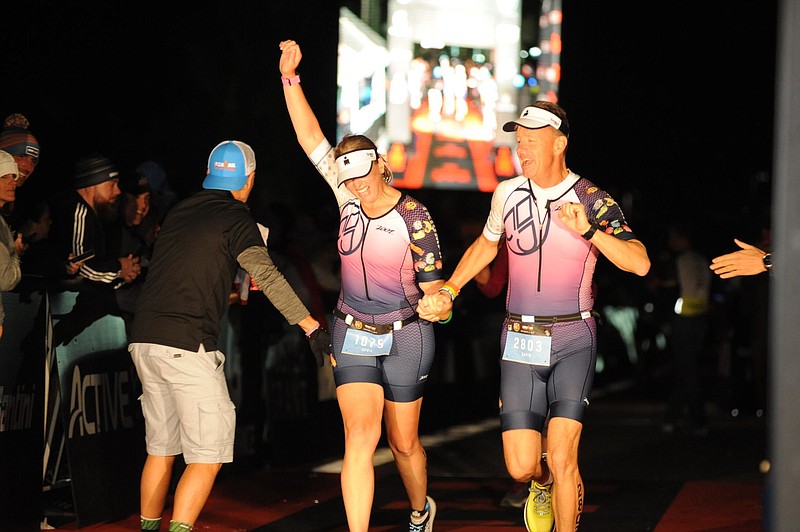For most, competing in an Ironman triathlon would be a lifetime achievement.
For Chattanooga's David Pearson and his wife April, it's a lifestyle.
David, 59, has now completed 12 full Ironman events. April, 48, has completed one. And this year, the couple is registered for three: Texas and California in October; Florida in November.
Leading up to the races, the Pearsons train six times a week, incorporating a variety of swim, bike and run workouts. Following the race, they trade a few of their high-intensity days for hikes or fast walks.
"We typically use (half) Ironmans to maintain a level fitness in between regular races," he says.
But preparation looks different for everyone.
"If you interview 10 of us, you'll have 10 different conversations," he says of the pool of Ironman competitors. "It's an evolving practice based on experience."
And that applies to gear lists, too.
Ironman lets its competitors pack a total of five drop bags, essentially stashes of supplies - sunscreen, extra socks or chafing cream, for instance - left along the route. And with a course that covers 140.6 miles, it's easy to want to over-prepare, David Pearson says.
Here, the seasoned triathlete helps explain the purpose of each drop bag, plus shares a few of the items he brings - and, more notably, doesn't bring - to the race.
___
Drop One: The Dry Clothes Bag
This is for an athlete's morning clothes, Pearson says: the clean, dry shirt and shoes worn to the start of race, the swim portion, with which that person will be happily reunited at the finish line.
Drop Two: The Swim-to-Bike Bag
This bag awaits athletes after the 2.4-mile swim. It is filled with the gear needed for their 116-mile bike ride: shorts, socks, shoes, helmet, for example. It may also contain items like energy gels or salt tablets.
But Pearson prefers "solid" nutrition. So his bag includes four individually wrapped PB&J sandwiches which he will carry in the back pockets of his bike jersey to snack on throughout the ride.
Drop Three: The Bike Special Needs Bag
"Special needs bags" are for emergencies, usually filled with extra nutrition or spare bike parts. These bags are available to athletes about halfway through the ride, around mile 56.
But Pearson doesn't pack one.
The instinct, he says, is "to think of everything that can fail and bring it."
But experience has taught Pearson that effort is often unnecessary.
So, he just preloads his bike with what he'll need, which includes items such as spare inner tubes, CO2 cartridges and nitrile gloves.
"If you've ever dealt with a chain drop or flat, you know why I carry the gloves," he says.
Drop Four: The Bike-to-Run Bag
Following the ride, this bag is filled with items such as running shoes, a hydration pack and a race bib.
Pearson also likes to place an extra watch in this bag.
"If I lose my watch in the swim - and I've seen it happen - I don't want to finish the race blind. I want to know where I'm at time-wise," he explains.
Drop Five: The Run Special Needs Bag
The final drop is also for emergencies and might include single-dose pain reliever or anti-diarrhea medications.
"You're going to also find that lot of people put a smorgasbord of food into that bag," Pearson says.
But he doesn't pack one at all - with one exception: inclement weather. Then, he may bring a base layer or jacket to use when the sun sets.
When it comes to fuel for the marathon, aid stations are located every mile, offering everything from potato chips to chicken broth to Gatorade, says Pearson.
Be sure to take advantage of those stops, he urges fellow contestants.
"I've made mistakes. I've not taken my nutrition when I should have. I've been to the medical tent. I've gone to the emergency room the day after a race," he says.
But throughout all the miles he's covered, he says he is most proud of his finish at the 2019 Florida Ironman.
"I crossed the finish line with April. It was her first official finish and my 12th – and at that same time, I was qualifying for the world championships. [The announcer] called us an 'Ironman couple,' and it was the highlight of everything."
___
The Ironman competition returns to Chattanooga on Sept. 26. To learn more, including how and where to watch, visit ironman.com/im-chattanooga.
